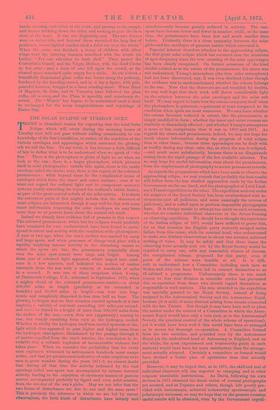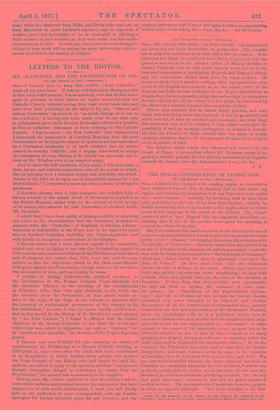THE SOLAR ECLIPSE OF TUESDAY NEXT.
THERE is abundant reason for expecting that the total Solar Eclipse which will occur during the morning hours of Tuesday next will not pass without adding considerably to our knowledge of the Sun's condition, or rather, of the condition of the various envelopes and appendages which surround the glowing orb we call the Sun. To say truth, it has become a little difficult of late to define what is to be understood when we speak of " the Sun." There is the photosphere or globe of light we see when we look at the sun ; there is a larger photosphere, which pictures itself in solar photographs ; outside this, again, there is the ruddy envelope called the sierra; next, there is the region of the coloured prominences ; while beyond these lie the complicated series of envelopes which form the inner and outer coronas ; even if we must not regard the zodiacal light and its component meteoric systems (really extending far beyond the zodiacal's visible limits), as part of the great central nebula of the solar system. It is about the outermost parts of this mighty nebula that the observers of total eclipses are interested, though it may well be that with more exact information respecting the solar envelopes, we may learn more than we at present learn about the central orb itself.
Indeed we already have evidence full of promise in this respect. The coloured prominences, which but for eclipses would probably have remained for ever undiscovered, have been found to corre- spond in extent and activity with the condition of the photosphere. A year or two ago, when the sun's surface was marked by many and large spots, and when processes of change took place with a rapidity implying intense activity in the disturbing causes to which the spots are due, the prominences (especially those over the solar spot-zones) were large and bright. Among them jets of coloured light appeared, which leaped into exist- ence in a few minutes, and indicated the motion of matter outwards from the sun with a velocity of hundreds of miles in a second. It was one of these eruptions which Young, of Dartmouth College, U.S., witnessed in September, 1872, when a mighty cloud of the coloured prominence-matter,—a cloud 400,000 miles in length (probably as far extended in breadth) and 30,000 miles in height—was rent into frag- ments and completely dispersed in less than half an hour. The glowing hydrogen was on that occasion carried upwards at a rate implying a velocity of out-rush exceeding 500 miles per second, and could be traced to a height of more than 200,000 miles from the surface of the sun,—even then not (apparently) ceasing to rise, but simply vanishing from view as the hydrogen cooled. Whether in reality the hydrogen itself was carried upwards or the, light which thus appeared to pass higher and higher came from the hydrogen atmosphere, illuminated by the passage through it of matter expelled from the sun's interior, the conclusion is in- evitable that a volcanic explosion of inconceivable violence had taken place. When we consider the probability that for every such explosion witnessed by astronomers hundreds must escape notice, and that jet-prominences indicative of solar eruptions were seen in great number during the years 1871-3, we cannot doubt that during all that time the activity indicated by the vast openings called sun-spots was accompanied by intense internal activity, leading to the expulsion of enormous masses of gaseous matter, accompanied probably by liquid and even solid missiles, from the interior of the sun's globe. May we not infer that the two forms of disturbance are due to one and the same cause ? This is precisely the inference to which we are led by recent observations, for both kinds of disturbance have latterly and
simultaneously become greatly reduced in activity. The sun- spots have become fewer and fewer in number, while, at the same time, the prominences have been few and much smaller than before. Evidently there is a close sympathy between the solar globe and the envelopes of gaseous matter which surround it.
Especial interest therefore attaches to the approaching eclipse, the first great solar eclipse which has occurred near the minimum of spot-frequency since the true meaning of the solar appendages has been clearly recognised. On former occasions of the kind doubts existed as to the nature of the prominences, the sierra was not understood, Young's atmosphere (the true solar atmosphere) had not been discovered, nay, it was even doubted (clear though the evidence was to mathematicians) whether the corona belongs to the sun. Now that the observers are not troubled by doubts, we may well hope that their work will throw considerable light on the relation between the solar envelopes and the solar orb itself. We may expect to learn how the corona comports itself when the photosphere is quiescent,—quiescent at least compared to its condition when spots are most numerous. We may learn whether the corona becomes reduced in extent, like the prominences, or simply modified in form ; whether the inner and outer coronas are similarly or dissimilarly affected ; and whether Young's atmosphere is more or less conspicuous than it was in 1870 and 1871. As regards the sierra and prominences, indeed, we may not hope for much clearer information during the progress of total eclipse than at other times ; because these appendages can be dealt with as readily during any clear, calm day, as when the sun is eclipsed, and much more satisfactorily, because there is no disquietude arising from the rapid passage of the few available minutes. Yet we may hope for useful information, even about the prominences, from the employment of photography to secure permanent records, As regards the preparations which have been made to observe the approaching eclipse, we may remark that probably the best results will follow from the leas studied approaches made by the Indian Government on the one hand, and the photographer of Lord Lind- say's Transit expedition on the other. The expedition sent out under the auspices of the Royal Society has been overburdened with in- structions (not all judicious, and some amazingly the reverse of judicious), and is called upon to perform impossible photographic feats. It is always unsafe to attempt too much on such occasions, whether we consider individual observers or the forces forming an observing expedition. We should have thought the experience of the Indian eclipse of 1871 would have sufficed to prove this, for on that occasion the English party narrowly escaped entire failure from this cause, while its nominal head, who endeavoured to make nine distinct observations in about two minutes, achieved nothing of value. It may be safely said that three times the- observing force actually sent out by the Royal Society would be required to carry out, with any reasonable chance of success, the complicated scheme proposed for this party, even if parts of the scheme were feasible at all. It is diffi- cult to understand how a Committee including such men as Stokes and Airy can have been led to commit themselves to so ill-advised a programme. Unfortunately there is too much reason to fear that division in scientific circles has prevented due co-operation from those who should regard themselves as responsible in such matters. The sum awarded to the expedition was specially granted to the Royal Society, instead of being assigned to the Astronomical Society and the Astronomer Royal, because (it is said) of some distrust arising from events connected with the late Transit. But though it may have been well to place the matter under the control of a Committee in which the Astro- nomer Royal would have only a vote (not, as in the Astronomical' Society, the practical control of the whole scheme of operations), yet it would have been well if this could have been so arranged as to secure his thorough co-operation. •A Committee formed from the two societies, and presided over by the Astronomer Royal (as the undoubted head of Astronomy in England, and on the whole, the most experienced and trustworthy guide in such matters) would have been far more satisfactory than the arrange- ment actually adopted. Certainly a committee so formed would have devised a better plan of operations than that actually provided.
However, it may be hoped that, as in 1871, the skill and zeal of individual observers will rise superior to cramping and in other respects unsuitable instructions. As Davis, following his own devices in 1871 obtained the finest series of coronal photographs yet secured, and as Tupman and others, though left poorly pro- vided with instruments, achieved noteworthy spectroscopic and polariscopic successes, so may we hope that on,the present occasion useful results will be obtained, even by the Government axpedi- tioit-, while the observers from India, and Davis (who was sent on froM Mauritius at Lord Lindsay's expense), may be expected, if weather prove but favourable, to be as successful in effecting a fresh advance on this occasion as they were under less favourable circumstances in 1871. In that case, the results secured during the eclipse of next week will be among the most noteworthy achieve- ments recorded in the history of eclipses.



































 Previous page
Previous page